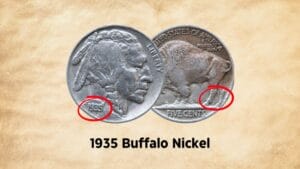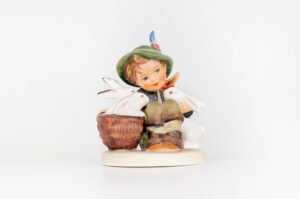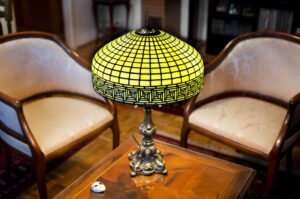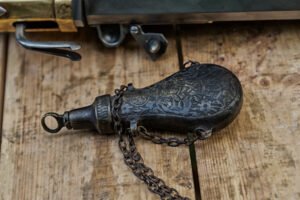If you have an old 1935 Buffalo Nickel coin in your old coins collection, separate it out and clean it; this ordinary coin can be worth tens of thousands of dollars today! Despite a higher mintage than its predecessor coins, the 1935 nickel is emerging as a point of attraction in the coin collecting world.
But do you know what exactly you need to look for to determine if it’s valuable? If not, this guide will help you. It’ll show you how to identify the most valuable features, including the mint marks and rare coin errors that can multiply the value of your 1935 Buffalo Nickel!
An Overview of the 1935 Buffalo Nickel History
The 1935 Buffalo Nickel is part of the Buffalo Nickel series, also known as the Indian Head Nickel series, first introduced in 1913. Designed by James Earle Fraser, the coin features a Native American profile on the front and an American bison (or buffalo) on the back.
This particular nickel coin re-established the full-fledged production of buffalo nickels at all mints after a two-year hiatus in 1932 and 1933. This year also saw an increase in mintage compared to the early 1930s, indicating the economic recovery under President Franklin D. Roosevelt’s working period.
However, after just three years, the Buffalo Nickel design was to be replaced by the Jefferson Nickel design, making the 1935 nickel one of the last coins of the series. This historical context adds to the coin’s worth and demand among coin collectors.
| 1935 Buffalo Nickel | Key Facts |
| Material (Composition) | 75% Copper, 25% Nickel |
| Minting Location | Philadelphia, Denver, San Francisco |
| Year of Minting | 1935 |
| Weight | 5.0 grams |
| Diameter | 21.2 mm |
| Designer | James Earle Fraser |
| Face Value | $0.05 (Five Cents) |
| Mint Marks | No Mint Mark – Philadelphia Mint, D – Denver Mint, S – San Francisco Mint |
| Total Mintage (All Facilities) | 80,656,000 |
Identifying a 1935 Buffalo Nickel’s Design & Composition
The 1935 Buffalo Nickel features the iconic bison design, making it a collector’s favorite coin. Let’s identify its design features and other physical characteristics:
1935 Buffalo Nickel Obverse Design
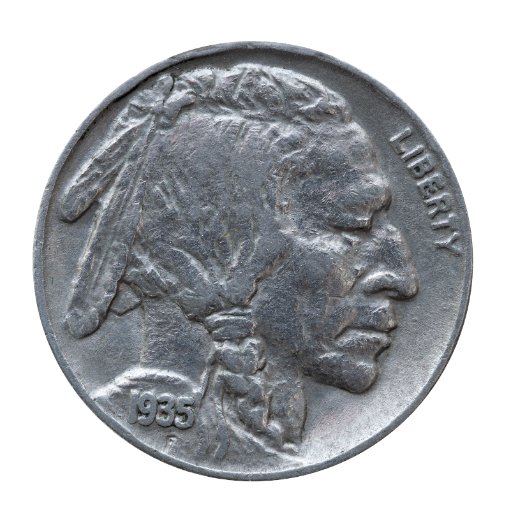
- Native American profile facing right
- The word “LIBERTY” written along the right rim
- The mint date “1935” below the neck
- The designer’s initial “F” (for Fraser) on the cutoff of the neck
1935 Buffalo Nickel Reverse Design
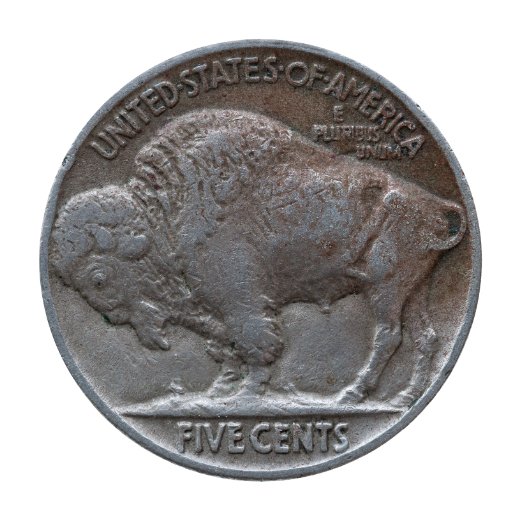
- American bison (buffalo) standing on a mound
- “UNITED STATES OF AMERICA” arched above the buffalo
- “E PLURIBUS UNUM” above the buffalo’s back
- “FIVE CENTS” inscribed on the mound below the buffalo
- The mint mark, if present, below “FIVE CENTS”
Coin Composition, Weight & Dimensions
The 1935 Buffalo Nickel is composed of 75% copper and 25% nickel, giving it a silvery appearance and a net weight of 5 grams. The coin measures approx. 21.2 mm in diameter and 1.95 mm in thickness, with a plain edge.
How to Assess a 1935 Buffalo Nickel Coin Value (3 Key Factors)
A circulated 1935 Buffalo Nickel is generally worth between $1 and $10, depending on condition and mint mark. However, some special 1935 nickels with rare characteristics can fetch as much as $57,000, like the MS68 example that sold on Heritage Auctions.
So, what are the special features and factors that decide the value of a 1935 Buffalo Nickel coin? Let’s find out:
1. Coin Grading and Condition
The first factor that majorly determines your 1935 nickel coin’s value is its condition. Generally, these coins are graded (by professional services, like PCGS, NGC, and ANACS) on a scale from Poor (P-1) to Perfect Mint State (MS-70).
The 1935 Buffalo Nickels graded MS-65 is worth around $150, while MS-68 examples can sell for $7,000 to a whopping $50,000 or more.
While it’s best to get a 1935 nickel graded professionally, as graded coins are more valuable, you can also assess its condition yourself. Look for the sharpness of the details in these key areas to do so:
- High points of the Native American’s cheekbone and hair
- Buffalo’s horn and shoulder
- The relief of the mint date
- The sharpness in lettering on reverse & obverse
- The presence or absence of contact marks
2. Mint Marks & Mintage
The second important factor that affects a 1935 buffalo nickel’s value is its mintage. The lower the mintage, the rarer and more valuable the coin. The total mintage for 1935 Buffalo Nickels was 80,656,000 coins across all mints.
You can easily identify the mint location of your buffalo nickel by the mint mark, which is present on the coin’s reverse below the face value.
Let’s understand how mint marks and mintage really impact the value:
- 1935 Buffalo Nickel No Mint Mark: The Philadelphia Mint produced 58,264,000 1935 nickels, the most among all mints, making them the most common ones. These coins have no mint mark. The 1935 no mint mark nickels are worth $5 – $20 in circulated condition and $50-$500 in uncirculated or mint state, with high-grade examples (MS-68) fetching $10,000 or more.
- 1935 D Buffalo Nickel: The second-highest mintage of 12,092,000 for the 1935 Buffalo Nickel was at the Denver Mint. You can identify these coins by the “D” mint mark on the reverse. These 1935-D buffalo nickels are worth $10 – $80 in circulated condition. For uncirculated coins with high grades (MS-67 or above), you can expect a price of $2,000 to $10,000 or more.
- 1935 S Buffalo Nickel: At 10,300,000, the San Francisco mint produced the fewest 1935 nickels with the “S” mint mark. These coins can sell for $50 to $3,000 in circulated condition, with high-grade mint state (MS-65) examples fetching $15,000 – $30,000.
I’ve curated a detailed 1935 Buffalo Nickel value chart for you to easily appraise your coin based on coin grades and mint marks.
| Coin Grades | 1935 5C No Mint Mark | 1935-D 5C | 1935-S 5C |
| Poor (0) to Extremely Fine (XF45) | Face value to $1 | $5 – $10 | $50 – $800 |
| Almost Uncirculated (AU50) to Mint State (MS60) | $10 – $15 | $20 – $40 | $850 – $3,500+ |
| Mint State (MS61 – MS64) | $20 – $150 | $40 – $150 | $4,000 – $15,000+ |
| Mint State (MS65 – MS66+) | $80 – $300 | $200 – $1,500 | $15,000 – $32,000+ |
| Mint State (MS67 – MS67+) | $500 – $3,000+ | $2,500 – $36,000+ | N/A |
| Mint State (MS68 or Above) | $7,500 – $55,000+ | $10,000 – $40,000+ | N/A |
3. 1935 Buffalo Nickel Errors & Rarities (Full List)
The third factor in determining a 1935 nickel’s worth is a coin error, a rare flaw that occurs to a single coin or a set of coins during the minting process. Here are the most valuable minting errors to find on a 1935 Buffalo Nickel.
Doubled Die Reverse
This mint error can be identified by a doubling of the reverse design. The doubling is particularly noticeable in the words “FIVE CENTS” and “PLURIBUS.” The average value of 1935 DDR coins ranges from $120 to $30,000, depending on coin grades. For example, an AU-55-graded example sold on eBay for $2,800.
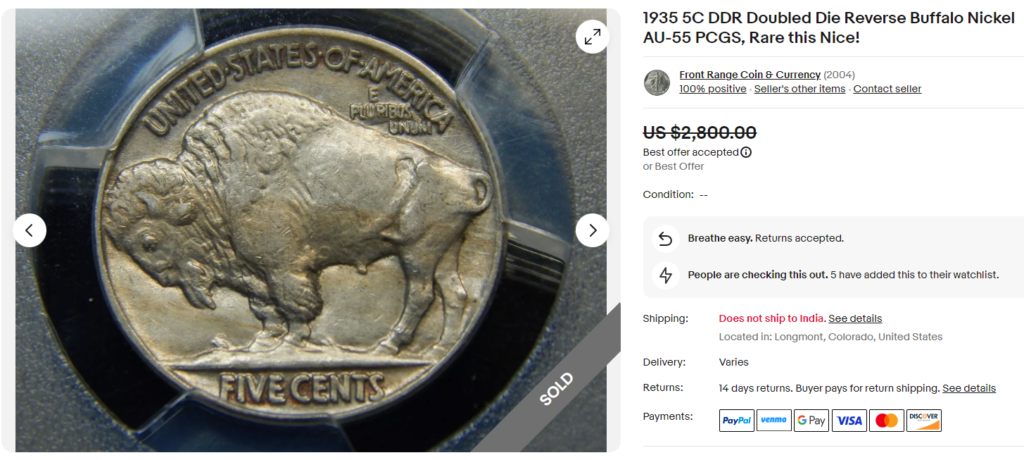
Another example is the notable sale of a 1935 MS-65 DDR Buffalo Nickel at an eye-popping auction record price of $104,650 on Bowers & Merena Auctions.
Repunched Mint Mark
This error occurs when a mint mark is punched more than once, leading to a visible doubling of the mint mark. Naturally, this rare mint error is found in 1935 nickels minted in Denver (D/D) and San Francisco (S/S).
Circulated RPM 1935 buffalo nickels can be worth $100 – $400, like this one that sold on eBay for $300.

Those in extremely fine condition (like XF-40) fetch around $1,000, and those in high-grade mint state fetch up to $7,000 or more. A perfect example is an MS-67 1935-S/S 5C RPM nickel that sold for $6,600 on the Stacks & Bowers auction.
Off-center Strike
This 1935 Buffalo Nickel error characterizes off-center designs on the obverse and reverse, which result from the coin planchet being misaligned during striking. A severe misalignment may also cause a part of the design to be missing.
The value of this coin error depends on the intensity of misalignment and the coin’s condition. 1935 nickels with minor off-center strikes (5-10%) can be worth $50-$500, like this MS-64 coin with a 5% off-center strike that a collector bought for $517 at Heritage Auctions.
Nickels with more dramatic off-center strikes (15% or above) can sell for more than $500, like another MS-64 example with a 15% off-center strike. This one sold for $1,527 on Stack’s & Bowers. See the value difference?
Can You Spot a 1935 Buffalo Nickel Counterfeit?

Identifying a fake 1935 Buffalo nickel can be difficult if you overlook the details. So, here are five easy steps to help you determine whether your nickel is real or fake!
- Check the Weight: A real 1935 nickel weighs 5 grams. If your coin weighs more or less than this, it’s likely a fake.
- Verify the Composition: Genuine Buffalo Nickels comprises 75% copper and 25% nickel. Fake coins may have different compositions, such as containing zinc or iron. You can perform a magnet test to see if your coin reacts. If it does, it could be fake.
- Double-check the Dimensions: Measure your coin’s diameter and thickness. Any different measurements than the Buffalo Nickel’s ideal specifications hint at a counterfeit.
- Examine the Mint Mark: Fake 1935 nickels often have forged “D” or “S” mint marks to portray the coin as valuable. Check the mint mark’s size, position, and style to see if it matches with authentic examples.
- Check the Date: Ensure the font and style of the mint date “1935” matches the ideal style of 1935 nickels. On counterfeit coins, the digits might lack precision or may be uneven or misaligned.
If you’re still unsure whether your Buffalo Nickel is real, you can send me a few high-quality pictures of your coin, and I can help you authenticate it.
In conclusion, a 1935 Buffalo Nickel can become a valuable collectible if it features certain mint marks or errors. So, whether you want to add this coin to your collection or sell one, ensure that you assess its best price using this guide with price charts.
And if you’re interested in collecting other nickels, consider looking out for the iconic 1937 Buffalo nickel, 1936 Buffalo nickel, and 1964 Jefferson nickel. These valuable coins are getting much attention from every coin collector for their rarity and monetary significance!
Note: This article is intended for informational, educational, and entertainment purposes only. Some images are illustrative and may not represent actual brands, products, or related entities. All trademarks, product names, brand logos, packaging, and other intellectual property referenced remain the exclusive property of their respective owners. Any brand mentions or references are provided solely for descriptive and educational context and do not imply any formal or commercial association.

